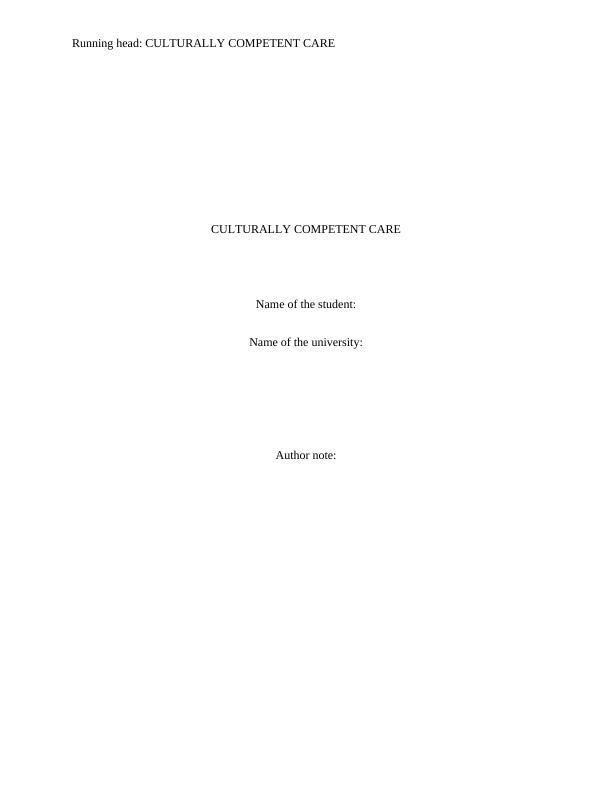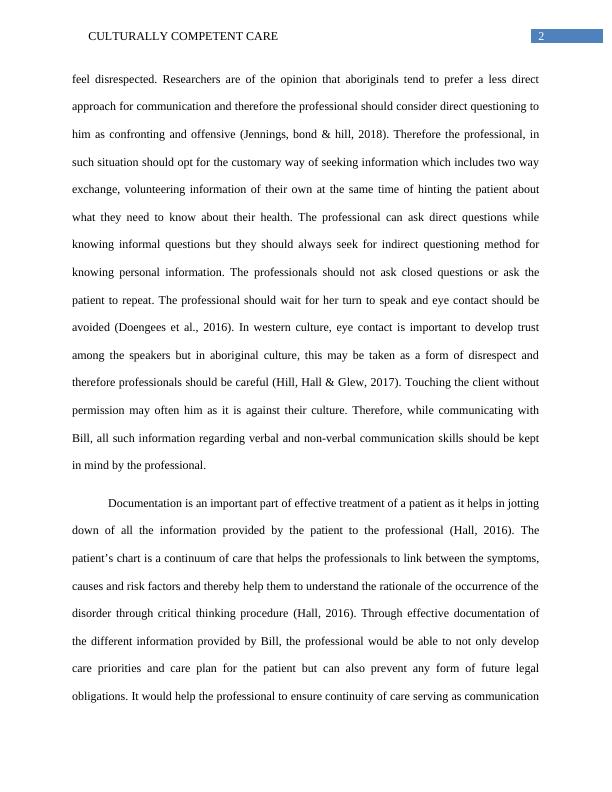Culturally Competent Care in Healthcare: A Case Study
Added on 2023-06-13
7 Pages1778 Words126 Views
Running head: CULTURALLY COMPETENT CARE
CULTURALLY COMPETENT CARE
Name of the student:
Name of the university:
Author note:
CULTURALLY COMPETENT CARE
Name of the student:
Name of the university:
Author note:

1CULTURALLY COMPETENT CARE
In the present generation, healthcare professionals are seen to provide importance to the
development of therapeutic relationship with clients who come for their service. Researchers
have defined this relationship as the bonding that develops between patients and professionals
based on mutual trust as well as respect along with nurturing of faith and hope (Lin, Green &
Bessarab, 2016). This kind of relationship also advises the professionals to be sensitive to self
and others ("Code of Ethics for Nurses in Australia", 2018). It also guides the professionals to
assist with gratification the emotional, physical and spiritual needs of the patients through proper
skills and skull so that the care provided to them is not only evidenced based but is also
culturally sensitive and culturally competent. Assignment will mainly show how the nursing
professionals can develop therapeutic relationship with patients with the help of the case study
that involves effective communication, person centered care approach and proper documentation.
Bruce is identified to have taken birth to an aboriginal mother and absence of influence of
his mother; he had spent his entire life with the principles and cultural traditions of his mother.
He loves his birthplace and even wants his grandchildren to visit his birthplace in order to make
them connected with his roots. Moreover, he also takes them to the local aboriginal youth
program so that they also develop bonding with the cultural traditions of the aboriginals. From
these cues, the professional should understand that he is quite sensitive about his aboriginal
cultural traditions and therefore the communication procedure that she would be adopting would
be culturally sensitive ("Standard of practice, Nursing and midwifery board of Australia", 2018).
After smiling, the professional should put significance to create a safe and approachable
environment for the client. The professional should take time to build rapport with the client and
actively listen to the client. Care should be taken that whether Bill is making eye contact or not
and accordingly the professional should make changes in his body language so that Bill does not
In the present generation, healthcare professionals are seen to provide importance to the
development of therapeutic relationship with clients who come for their service. Researchers
have defined this relationship as the bonding that develops between patients and professionals
based on mutual trust as well as respect along with nurturing of faith and hope (Lin, Green &
Bessarab, 2016). This kind of relationship also advises the professionals to be sensitive to self
and others ("Code of Ethics for Nurses in Australia", 2018). It also guides the professionals to
assist with gratification the emotional, physical and spiritual needs of the patients through proper
skills and skull so that the care provided to them is not only evidenced based but is also
culturally sensitive and culturally competent. Assignment will mainly show how the nursing
professionals can develop therapeutic relationship with patients with the help of the case study
that involves effective communication, person centered care approach and proper documentation.
Bruce is identified to have taken birth to an aboriginal mother and absence of influence of
his mother; he had spent his entire life with the principles and cultural traditions of his mother.
He loves his birthplace and even wants his grandchildren to visit his birthplace in order to make
them connected with his roots. Moreover, he also takes them to the local aboriginal youth
program so that they also develop bonding with the cultural traditions of the aboriginals. From
these cues, the professional should understand that he is quite sensitive about his aboriginal
cultural traditions and therefore the communication procedure that she would be adopting would
be culturally sensitive ("Standard of practice, Nursing and midwifery board of Australia", 2018).
After smiling, the professional should put significance to create a safe and approachable
environment for the client. The professional should take time to build rapport with the client and
actively listen to the client. Care should be taken that whether Bill is making eye contact or not
and accordingly the professional should make changes in his body language so that Bill does not

2CULTURALLY COMPETENT CARE
feel disrespected. Researchers are of the opinion that aboriginals tend to prefer a less direct
approach for communication and therefore the professional should consider direct questioning to
him as confronting and offensive (Jennings, bond & hill, 2018). Therefore the professional, in
such situation should opt for the customary way of seeking information which includes two way
exchange, volunteering information of their own at the same time of hinting the patient about
what they need to know about their health. The professional can ask direct questions while
knowing informal questions but they should always seek for indirect questioning method for
knowing personal information. The professionals should not ask closed questions or ask the
patient to repeat. The professional should wait for her turn to speak and eye contact should be
avoided (Doengees et al., 2016). In western culture, eye contact is important to develop trust
among the speakers but in aboriginal culture, this may be taken as a form of disrespect and
therefore professionals should be careful (Hill, Hall & Glew, 2017). Touching the client without
permission may often him as it is against their culture. Therefore, while communicating with
Bill, all such information regarding verbal and non-verbal communication skills should be kept
in mind by the professional.
Documentation is an important part of effective treatment of a patient as it helps in jotting
down of all the information provided by the patient to the professional (Hall, 2016). The
patient’s chart is a continuum of care that helps the professionals to link between the symptoms,
causes and risk factors and thereby help them to understand the rationale of the occurrence of the
disorder through critical thinking procedure (Hall, 2016). Through effective documentation of
the different information provided by Bill, the professional would be able to not only develop
care priorities and care plan for the patient but can also prevent any form of future legal
obligations. It would help the professional to ensure continuity of care serving as communication
feel disrespected. Researchers are of the opinion that aboriginals tend to prefer a less direct
approach for communication and therefore the professional should consider direct questioning to
him as confronting and offensive (Jennings, bond & hill, 2018). Therefore the professional, in
such situation should opt for the customary way of seeking information which includes two way
exchange, volunteering information of their own at the same time of hinting the patient about
what they need to know about their health. The professional can ask direct questions while
knowing informal questions but they should always seek for indirect questioning method for
knowing personal information. The professionals should not ask closed questions or ask the
patient to repeat. The professional should wait for her turn to speak and eye contact should be
avoided (Doengees et al., 2016). In western culture, eye contact is important to develop trust
among the speakers but in aboriginal culture, this may be taken as a form of disrespect and
therefore professionals should be careful (Hill, Hall & Glew, 2017). Touching the client without
permission may often him as it is against their culture. Therefore, while communicating with
Bill, all such information regarding verbal and non-verbal communication skills should be kept
in mind by the professional.
Documentation is an important part of effective treatment of a patient as it helps in jotting
down of all the information provided by the patient to the professional (Hall, 2016). The
patient’s chart is a continuum of care that helps the professionals to link between the symptoms,
causes and risk factors and thereby help them to understand the rationale of the occurrence of the
disorder through critical thinking procedure (Hall, 2016). Through effective documentation of
the different information provided by Bill, the professional would be able to not only develop
care priorities and care plan for the patient but can also prevent any form of future legal
obligations. It would help the professional to ensure continuity of care serving as communication

End of preview
Want to access all the pages? Upload your documents or become a member.
Related Documents
(PDF) Assessment of nurse-patient communicationlg...
|11
|3229
|10
Healthcare Environment - Assignment PDFlg...
|5
|1014
|68
Analysis of a Case Study on Paternalism, Therapeutic Relationship, Informed Decision Making and Cultural Safetylg...
|11
|2845
|306
Case study on Nursing - Assignment PDFlg...
|9
|2236
|83
CHCAOD004: Assess Needs of Clients with AOD Issueslg...
|6
|1194
|132
Communication Skills Training Program for Nurses in Aboriginal Healthcarelg...
|6
|2287
|413
